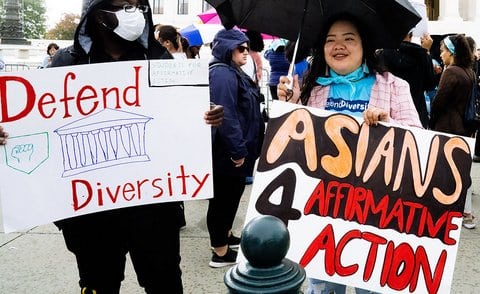
26 Jul ‘An Attack on All Communities of Color’: Supreme Court Decision to End Affirmative Action Seeping Into Other Areas of Education and Beyond, Experts Say

(“Affirmative Action” by Victoria Pickering via Flickr / CC BY-NC-ND 2.0 license)
By Joe Porrello
About one year has passed since the U.S. Supreme Court overturned affirmative action and ended race considerations in college admissions.
Experts and advocates who gathered June 28 for an Ethnic Media Services national press teleconference say the landmark ruling is unlawfully spilling over into other areas of education.
According to EMS, partial-year data shows that applications from non-white students are greater than ever before. However, such strides have been outweighed by new hurdles to higher learning created by technical issues in the most recent Free Application for Federal Student Aid rollout.
According to national polls conducted by the Foundation for Individual Rights and Expression and the University of Chicago, Americans’ confidence in higher education is lower than ever, particularly among young people, women and Democrats.
Thomas Saenz, president of the Mexican American Legal Defense and Educational Fund, says admissions data is incomplete and may mask discrimination because many colleges and universities have stopped collecting data regarding race and ethnicity.
According to Saenz, failure to have such information violates Title 19 of the Civil Rights Act of 1964. Used in the Supreme Court’s decision to end affirmative action, the law requires that institutions receiving federal funding are not using criteria that have an unjustified discriminatory effect.
“Doing so requires the data,” he said.
>>>From Our Archives: What a Supreme Court Overturn of Affirmative Action at Two Universities Could Mean<<<
If and when the data does emerge, it may still be inaccurate due to race and ethnicity not being considered, Saenz noted. He pointed to a rapidly growing young Latinx population whose increase in applications might not reflect a drop in their acceptance rate, “cushioning what would otherwise be a precipitous drop,”
All underrepresented groups are specifically hindered by the newest FAFSA rollout, according to Saenz, who called its negative impact “extreme.”
“We have to look to the federal government to compensate these low-income students… who have faced barriers from this reform that was designed to make the process easier but has, in fact, made it impossible for too many students,” he said.
Dr. Vikash Reddy, who as vice president of research at the Campaign for College Opportunity promotes access to higher education to minority students, says the FAFSA debacle is delaying students’ ability to make their enrollment decisions and causing deadlines to be pushed.
“There are a lot of colleges and universities still trying to decide who their final classes are going to be… It’s not equitable if you admit a student to a campus they can’t afford or one where they don’t feel welcome,” he said. Reddy added that a lack of race and ethnicity data makes it difficult to know just how much adversity students of color, with disabilities, or part of the LGBTQ+ community are now and will be facing in the FAFSA process.
“The students who were able to access the FAFSA are those who have resources,” he said.
>>>Read: Student Debt Fuels Racial Wealth Gap, Advocates Say<<<
The California Legislature is working on separating state aid from FAFSA, according to Reddy, but that could require extra forms to fill out.
He also noted the ripple effect of last year’s Supreme Court ruling making waves upon diversity, equity and inclusion programs on campuses. Reddy pointed to 45 bills introduced across the U.S. targeting DEI groups, highlighting legislation in Texas and Florida that eliminated DEI funding and related job positions and creates legal impediments to schools wanting to provide resources to such groups.
>>>Read: New School Year Beset by Teacher Shortages, Anti-Diversity Efforts<<<
As further example of the trickle down from last year’s decision, Reddy says officials in multiple states have interpreted the ruling by taking away race- and ethnicity-related scholarships intended for minority students.
Saenz said both DEI programs and race- and ethnicity-related scholarships are fully legal as long as they remain available to all who apply.
Jin Hee Lee, director for strategic initiatives at the NAACP Legal Defense Fund, says college admissions were not fair even with affirmative action, but the Supreme Court’s decision has altogether muddied the interpretation of inclusivity.
“We’re now in a time where a university administrator… is accused of discrimination because of their commitment to equality,” she said, referring to those under scrutiny for trying to keep DEI programs alive on their campuses.
The Supreme Court ruling claims college admissions to be a zero-sum game and that when students of one race benefit, it’s at their peers’ expense
“If you do not win in this zero-sum game… then you are not qualified, or you are not smart enough or hard-working enough,” said Lee. “If you believe that the college admissions process is fair and that the results leading to a university having incredibly extreme racial disparities in terms of who they admit, then what you are essentially believing in is that students of certain races are naturally more talented and more qualified to enter that university.”
John C. Yang, president of Asian Americans Advancing Justice – AAJC, says the Supreme Court’s ruling is “taking the United States backwards” and that “the impact has potential to be seismic.”
“It was clear from the beginning that the decision was an attack on all communities of color… The intent was to divide all of us,” said Yang.
He says AAJC has heard from many students hesitant to apply to certain colleges because of the attitudes around diversity some schools hold.
Saenz said many students don’t know if including race and ethnicity in their application essay will harm their acceptance chances because it is not specified or encouraged by schools.
Developing alternative admissions criteria, he says, will partially limit the discriminatory nature of applications, standardized tests, teacher and counselor recommendations, and assignment into Advanced Placement high school courses.
>>>From Our Archives: The UC Needs To Drop the SAT, Says This Richmond Teacher<<<
Reddy says holistic admissions review processes are fair and equitable and, if well-developed, would mitigate adverse effects of the Supreme Court’s decision.
The holistic process takes into account family and high school circumstances, which Reddy says illustrates how a student takes advantage of opportunity and will handle the adversity of attending college, “giving the admissions reader a chance to understand the student before understanding their scores.”
As another tool for educational equality, he noted California’s interest in following multiple states that have successfully ended legacy considerations in college admissions.
Beyond admissions, Reddy says the moment highlights a need to advocate for policy reform across all levels of education.
And it’s not just about schooling, says Lee, who pointed to the connection with employment and how students’ future job opportunities could be less inclusive due to last year’s ruling.
“This is something that should be thought very seriously about in this year given that we are embarking on an important election… at the state, federal and local level that will have an impact on everyone,” she said.





No Comments